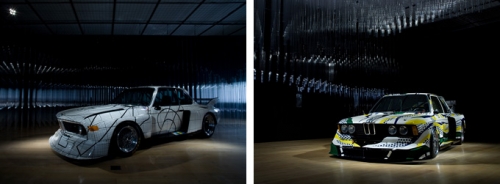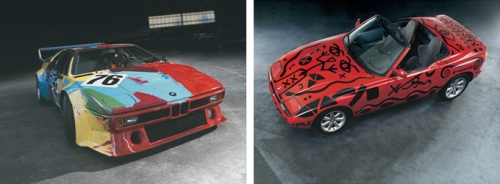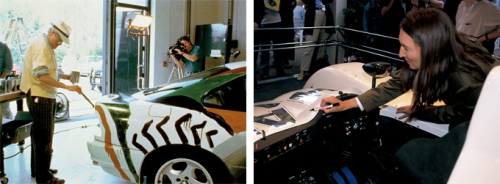When technology and art meet
Over the last 30 years, BMW, one of the world’s leading automobile manufacturers, has implemented over 100 cultural support programs. Of these, the BMW Art Car Collection, which features BMW cars transformed into artworks, is a peculiar case without parallel. We look into the basic policy of the company as it applies to a range of initiatives in such diverse fields as contemporary art, architecture, and music.
Research/text: ART iT
The Art Car Collection: from Calder to Eliasson
Art Cars are cars that have been transformed into artworks by selected artists. A part of BMW’s Art Car Collection is currently on display at the Mori Arts Center Gallery (until June 8). Inside the gallery, some 10,000 transparent pipes, backlit so that beams of light run through them, hang in rows surrounding the cars. According to architect Aoki Jun, who was responsible for the exhibition design, the image of “cars dashing between the clouds” was partly inspired by the fact that the cars are on display in a gallery on the 52nd floor.
The show features a total of five Art Cars created by Frank Stella, A.R. Penck, Roy Lichtenstein, David Hockney, and Jenny Holzer, including some that actually participated in races such as the Le Mans 24-hour race. In 1975, racing driver and art auctioneer Herve Poulain asked his friend, sculptor Alexander Calder, to paint his own racing car. The project was taken up by BMW, and the collection eventually grew to its current size of 15 vehicles. In 2005, to mark the 30th anniversary of the birth of the collection, it was decided to take the collection on a world tour. This is the first time the Art Cars have been exhibited in Japan.
In 2005, Olafur Eliasson was commissioned to produce the 16th Art Car after a selection process that involved six curators and other experts from various countries. In stark contrast to the Andy Warhol episode, which saw the artist finish painting his car in just 20 minutes, Eliasson spent some three years making inquiries and studying various ideas with different departments within BMW before completing his car. And whereas most of the previous artists chose to decorate the exterior of their vehicles, Eliasson’s concept was completely new. He started by stripping his hydrogen-powered racing car to its frame, then he wrapped it in translucent material and coated it with a layer of ice by hosing it with chilled water, illuminating it from the inside with lights. The finished work, which swept away the Art Car tradition, went on display in 2007 at the San Francisco Museum of Modern Art, where it attracted considerable attention.
Support for young artists
According to BMW AG Head of Cultural Communications Thomas Girst, projects like the Art Car Collection in which BMW products are prominent are the exception rather than the rule.
“As a general rule, our basic policy on activities is to support young artists over the long term, and we take care to ensure that the BMW name, which is well known throughout the world, isn’t too conspicuous. We’ve established a number of prizes for young artists, such as the Premio de Pintura, a competition for young painters in Spain, and the Nationalgalerie Prize for Young Art, and we also support the AkademieGalerie. We have a policy of continuing our support for the winners of these prizes for a minimum of three years.”
On the other hand, there are cases where the BMW name is strategically pushed to the front. For example, wealthy patrons gather together for brief periods during art fairs in places like Basel and Miami. By sponsoring these fairs and providing VIP shuttle and other services, BMW looked to use these events to attract future patrons.
“However, because the fairs in Basel and Miami seemed to go from strength to strength each year, and because so many alternative fairs sprang up, we decided to stick to our policy of providing support during the initial stage only and concluded our associate partnership as of 2007, ending our six-year commitment. We intend to continue our support for other events such as the Frieze Art Fair, FIAC, and Paris Photo.”
Whether the recipient is an individual or a group, the company’s approach of supporting the potential of youth is the same.
The ideal shape of cultural activities
In fields other than contemporary art, too, a feature of BMW’s support of the arts is the global and varied nature of its activities, which include commissioning cutting edge architects such as Zaha Hadid and Coop Himmelb(l)au to design corporate buildings, staging opera, and supporting classical, jazz, and other performers.
“Culture comprises a range of different elements, and we make an effort to provide support suited to the context and background in each country.”
Girst himself studied art history and has pursued various occupations that enabled him to make full use of his specialist knowledge. He relies on a network of curators and other experts active on the international stage and continually holds discussions with these people and strategically considers the benefits BMW might gain as a company before making decisions as to what to support and in what way.
“Ideally we want people to think that particular works or artists are of a high quality because they have the support of BMW, and accordingly that BMW’s products are also of a high quality.”
Another distinguishing feature of BMW is that for some time employees have been given the opportunity to engage with art and culture. In Munich, where BMW once had a manufacturing plant, there was no autobahn linking the plant to the city center. So in an effort to provide employees with more opportunities to enjoy art, the company began offering tickets to exhibitions and theaters at a discount. Gallery tours, opera visits, and other events organized especially for the company’s 35,000 employees are still held every three months.
Girst is keeping a close eye on the trend that’s seeing more and more Japanese artists as well as artists from China and other parts of Asia making inroads into Europe and North America. In light of this, many people will be keen to see how things unfold at BMW, which has consistently provided support suited to the cultural infrastructure of each country.
 Left: Frank Stella, Art Car 1976, 3.0 CSL
Left: Frank Stella, Art Car 1976, 3.0 CSLRight: Roy Lichtenstein, Art Car 1977, BMW 320i group 5 racing version
Installation views at Mori Art Center
 Left: Andy Warhol Art Car 1979, BMW M1 group 4 racing version, Courtesy BMW AG
Left: Andy Warhol Art Car 1979, BMW M1 group 4 racing version, Courtesy BMW AGRight: A.P. Penck, Art Car 1991, BMW Z1
 Left: David Hockney painting Art Car 1995, BMW 850 CSi
Left: David Hockney painting Art Car 1995, BMW 850 CSiRight: Jenny Holzer signing Art Car 1999, BMW V12 LMR
2008.5.20
